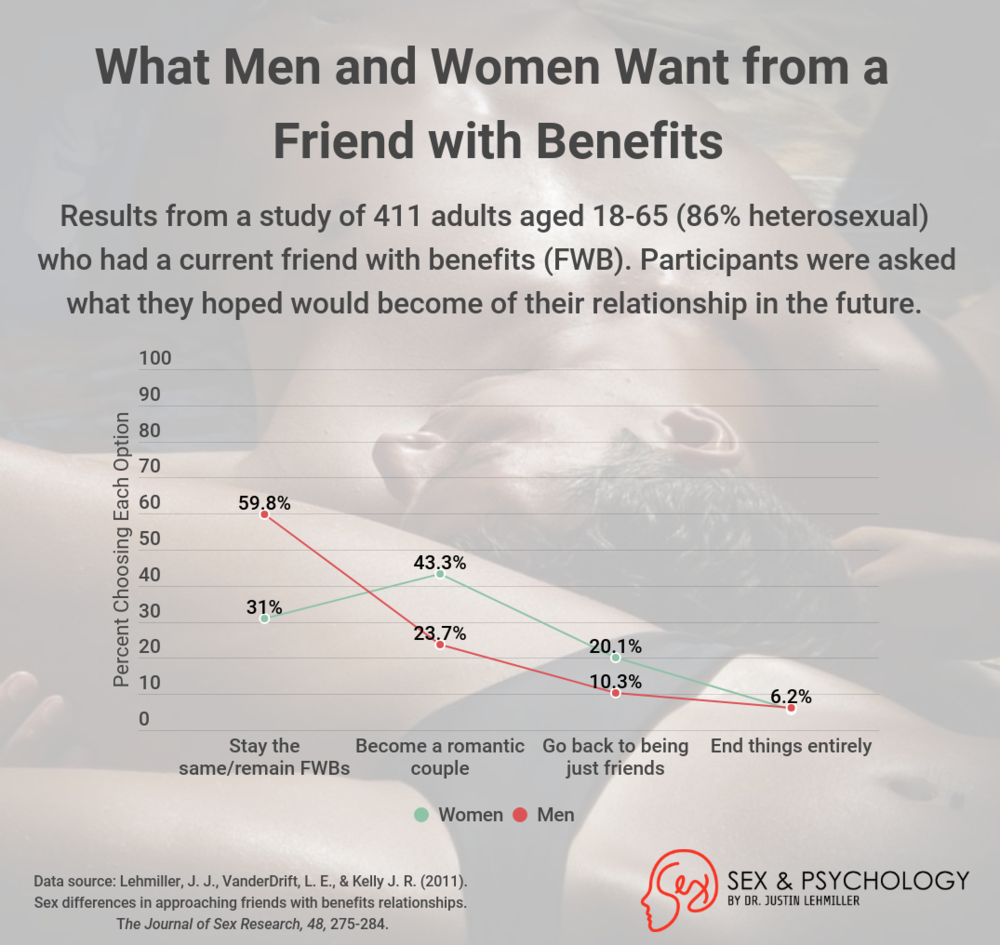When people become friends with benefits (FWBs), what is it that they truly want from that arrangement? Are they just in it for the “benefits” (that is, sex)? Or are they perhaps looking for more? I’ve conducted some research on this subject and here’s what I found.
I surveyed 411 adults online, all of whom said they currently had at least one FWB. Participants ranged in age from 18 to 65 and most (86%) were heterosexual. Everyone was asked what they hoped would come of their FWB arrangement in the future, which could mean staying FWBs long-term, becoming romantic partners, becoming friends only, or having no relationship of any kind.
It turned out that men and women provided significantly different answers to this question. While the vast majority of women (69%) wanted their relationship to change in some way, the majority of men (60%) wanted to keep things just as they are. In other words, women were more likely to see their FWBs as a temporary state, whereas men were more likely to see their FWBs as an end state.
For a look at which specific types of relationship changes men and women were most interested in, check out the infographic below.
As you can see above, nearly 1 in 4 men and 2 in 5 women expressed hope that their FWB would eventually turn into a romantic relationship. So while women were more likely to go into these relationships with the hope of finding love, a significant number men clearly do, too.
What this tells us is that, while a lot of people describe FWBs as having “no strings attached,” there seem to be strings quite a bit of the time. Perhaps that’s why these relationships often become complicated.
Want to learn more about Sex and Psychology? Click here for more from the blog or here to listen to the podcast. Follow Sex and Psychology on Facebook, Twitter (@JustinLehmiller), or Reddit to receive updates. You can also follow Dr. Lehmiller on YouTube and Instagram.
To learn more about this research, see: Lehmiller, J. J., VanderDrift, L. E., & Kelly J. R. (2011). Sex differences in approaching friends with benefits relationships. The Journal of Sex Research, 48, 275-284.
Image Source: 123RF (photo) and Dr. Justin Lehmiller (infographic)
You Might Also Like:


 Anal Beads
Anal Beads Anal Vibrators
Anal Vibrators Butt Plugs
Butt Plugs Prostate Massagers
Prostate Massagers
 Alien Dildos
Alien Dildos Realistic Dildos
Realistic Dildos
 Kegel Exercisers & Balls
Kegel Exercisers & Balls Classic Vibrating Eggs
Classic Vibrating Eggs Remote Vibrating Eggs
Remote Vibrating Eggs Vibrating Bullets
Vibrating Bullets
 Bullet Vibrators
Bullet Vibrators Classic Vibrators
Classic Vibrators Clitoral Vibrators
Clitoral Vibrators G-Spot Vibrators
G-Spot Vibrators Massage Wand Vibrators
Massage Wand Vibrators Rabbit Vibrators
Rabbit Vibrators Remote Vibrators
Remote Vibrators
 Pocket Stroker & Pussy Masturbators
Pocket Stroker & Pussy Masturbators Vibrating Masturbators
Vibrating Masturbators
 Cock Rings
Cock Rings Penis Pumps
Penis Pumps
 Wearable Vibrators
Wearable Vibrators Blindfolds, Masks & Gags
Blindfolds, Masks & Gags Bondage Kits
Bondage Kits Bondage Wear & Fetish Clothing
Bondage Wear & Fetish Clothing Restraints & Handcuffs
Restraints & Handcuffs Sex Swings
Sex Swings Ticklers, Paddles & Whips
Ticklers, Paddles & Whips



















